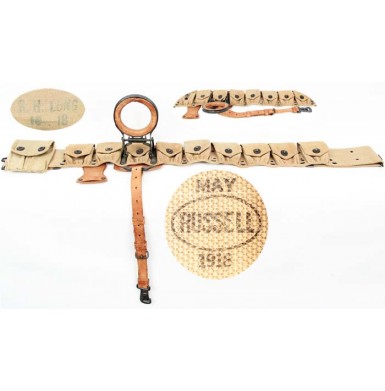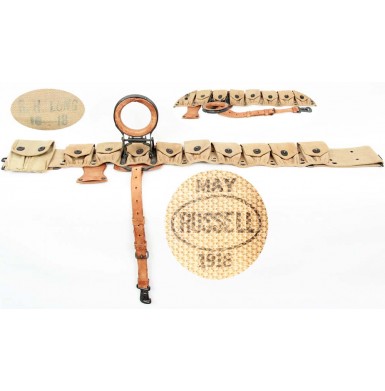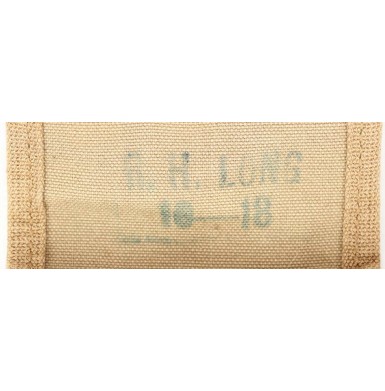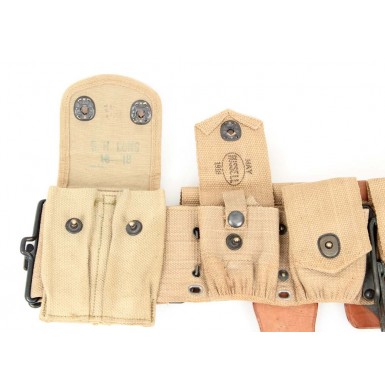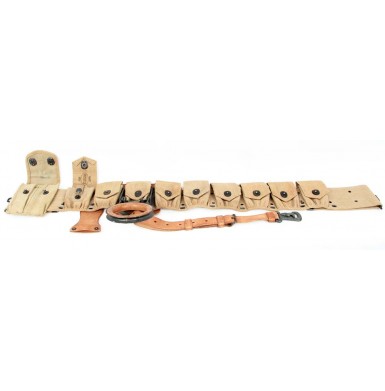Experimental US M-1912 Cavalry Belt Rig
- Product Code: ALKH-1271-SOLD
- Availability: Out Of Stock
-
$1.00
This is a VERY FINE to NEAR EXCELLENT condition example of the very scarce US M-1912 Experimental Cavalry Belt. This ammunition belt and firearm carrying system was introduced at the same time that the days of the cavalry on horseback were becoming numbered. While the horse soldier would remain important for a few more years because of his ability to travel and scout in rough terrain, the advent of motorized vehicles and aircraft soon replaced the cavalry in that roll. The introduction of reliable machine guns effectively neutralized the cavalry as a fighting force by 1914, but it was a lesson that was hard for the old breed cavalry officers to learn. The Model of 1912 Cartridge Belt, Cal. 30, Cavalry was part of a complete set of cavalry accouterments that were designed and approved by the Cavalry Equipment Board at Rock Island Arsenal in 1912. The complete set included a new saddle and bridle, as well as other related horse equipment such as pommel pockets and a picket pin, and a specialized “boot” that was to be used in conjunction with the new belt to carry the trooper’s M-1903 rifle. Other new items adopted (or at least approved for field trials) were the M-1912 holster for the 1911, a new ammunition bandolier, and other sundry items such as a new pattern of ration bag. As with all things military, the entire group was intended to be used together as a “system”. Unfortunately for the Cavalry Board, most of the items adopted for experimentation in 1912 were not well thought of in the field and were subsequently abandoned, modified or replaced by the items that these accouterments were originally meant to supersede. One of the few somewhat successful items to come out of the 1912 accouterments group was the M-1912 holster with its drop design and swivel that made it particularly well adapted for use by mounted men or those who were seated on a regular basis. As author and researcher R. Stephen Dorsey notes, the new M-1912 saddle was so poorly thought of in the field that during Mexican Punitive Expedition against Poncho Villa, General Pershing’s men practically begged for the return of their M-1904 McClellan saddles! The M-1912 belt was a classic example of Rube Goldberg design by committee, with no one on the committee having been experienced in the use of the item being designed. The cartridge belt abandoned the saber hanger system and provided no way for the cavalryman to carry his saber, which even in 1912 was considered a primary weapon for a mounted man. However, it did include a nightmarish system to attach the M-1903 rifle to the belt. This included a long, adjustable leather strap with a snap hook that was designed to secure to the triggerguard of the rifle. A large steel ring with a leather liner was attached to the belt at the about the left kidney position, which was designed to fold out 90-degrees, perpendicular to the horseman’s body, through which the muzzle of the rifle was supposed to ride. The butt of the gun was supposed to ride in a boot, suspended from the left rear of the saddle, which was also part of the new “system”. While this contraption made sure the rifle and the soldier remained attached to each other at all times, it was an incredible awkward way to carry a rifle. The stock riding just behind the left leg with the muzzle riding up towards the left rear of the rib cage and spine made the gun a real hazard if the soldier was thrown from his mount, or if he even had to dismount quickly. I have no doubt a few broken legs and even more bruised or broken ribs could be directly attributed to the design of the M-1912 belt system. The balance of the belt was standard cartridge belt design of the era, much of which would continue through the Second World War. The belt incorporated 9 pouches for stripper clips holding the .30-06 ball ammo that was issued with the M-1903 rifle. Each pouch secured to clips holding five rounds each, giving the trooper a reserve of 90 rounds beyond what was carried in his rifle. The location that would traditionally have held a 10th pouch on an infantry belt had snaps to attach a 2-pocket magazine pouch that carried a pair of spare M-1911 magazines. A leather accessory frog was also provided on the belt, between the rifle ring and the pistol magazine pouch, to carry a combination picket pin field tool, including either a hatchet, shovel or pick. Initially Mills manufactured the experimental web cartridge belts with the leather and steel fittings produced by the Rock Island Arsenal. The earliest belts used Eagle Snaps to secure the pockets, but there were soon replaced by the ubiquitous “Lift The Dot” snaps that pervade US military accouterments through both world wars. While some of the initial production of belts surely saw issue with Pershing’s men serving in Mexico, it is unlikely that the belts saw much further field service and likely little combat if any. Even though the belt system was clearly obsolete, and the roll of horse cavalry was certainly severely curtailed by the last years of the Great War, it appears that at least some additional M-1912 cavalry belts were contracted for as the US ramped up to enter World War I. In addition to Mills, the original contractor to produce the belts, orders were placed with Russell as well. It has been suggested by author Dorsey that these orders were the result of “war jitters”, with the army ordering obsolete and unnecessary accouterments just in case they might be needed. It is these examples that are normally encountered today, with 1917 or 1918 production dates, and as Dorsey so eloquently puts it: “I have never seen one of these later belts which gives indication of having come near a horse.” (see R. Stephen Dorsey’s US Martial Web Belts & Bandoliers 1903-1981 pp17-19 for more information and as the source for most of the above background information) Even though these later belts saw little if any use, they are still extremely rare on today’s collectors’ market and any example of an Experimental M-1903 Cavalry Belt is a prized addition to the collection of US accouterment collector.
This example of the scarce Experimental M-1903 Cavalry Belt is in about VERY FINE to NEAR EXCELLENT condition. The belt is 100% complete and correct and is fully functional, showing little (if any) use. The belt was produced under contract by Russell and is clearly marked with a black ink stamp, inside the forward most ammunition pocket flap: MAY / RUSSELL / 1918, with the “Russell” name within an oval. The inside flap of the .45 magazine pouch is marked in a somewhat faded blue ink stamp: R. H. LONG / 10-18. Although there is no indication that any of the M-1912 experimental accouterments were ever issued for service in the First World War, it is nice that both pieces are manufacture dated prior to the armistice in November of 1918. All 9 of the ammunition pockets are of the correct “puckered bottom” design used by Russell when weaving their web ammunition belts. All of the closure snaps function correctly and all of the ammunition retaining straps are in place inside the pockets. The leather attachments are in excellent condition showing only some light age scuffing and minor surface wear, but no significant discoloration or wear. All of the leather remains supple and functional. The rifle ring operates as it should, and snaps securely into place at a 90-degree angle to the belt, and squeezing the releases inside the mount allows it to fold back down again smoothly. The leather rifle hanger strap retains its original adjustment buckle and triggerguard snap, both of which are still completely functional. All of the metal hardware retains about 90%+ of its original blued finish with only some minor wear and fading and some lightly scattered oxidized freckling mixed with the blued finish. The woven belt is in strong and complete condition with only some minor discoloration due to storage and possibly moisture. The stitching is all tight and sound, as is the weaving of the webbing, and the cloth shows no significant wear. The belt would certainly be quite usable today, if you were so inclined.
Overall this is a really fantastic example of a very scarce experimental US military belt system from the last days of the horse cavalry and immediately before the creation of the armored cavalry. The belt is great shape with only some light staining and is 100% complete, correct, original and functional. This would be a great addition to any advanced US cavalry collection and is one of those center piece accouterments that you will be very proud to display with your other early 20th century through WWI cavalry gear.
SOLD
